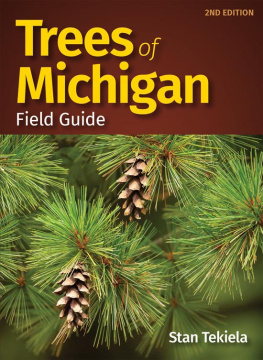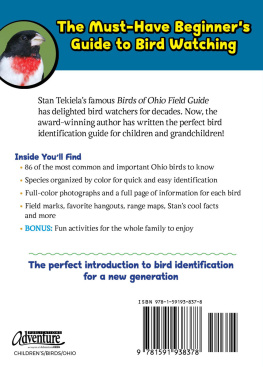

Edited by Sandy Livoti, Brett Ortler and Kate Johnson
Cover, book design and illustrations by Jonathan Norberg
Range maps produced by Anthony Hertzel
Cover photo: Northern Cardinal by Stan Tekiela
All photos by Stan Tekiela except (female) by Jim Zipp
To the best of the publishers knowledge, all photos were of live birds. Some were photographed in a controlled condition.
10 9 8 7 6 5 4 3 2 1
Birds of Pennsylvania Field Guide
First Edition 2000
Second Edition 2004
Third Edition 2021
Copyright 2000, 2004 and 2021 by Stan Tekiela
Published by Adventure Publications
An imprint of AdventureKEEN
310 Garfield Street South
Cambridge, Minnesota 55008
(800) 678-7006
www.adventurepublications.net
All rights reserved
Printed in China
ISBN 978-1-64755-088-2 (pbk.); ISBN 978-1-64755-089-9 (ebook)
TABLE OF CONTENTS
WHATS NEW?
It is hard to believe that its been more than 20 years since the debut of Birds of Pennsylvania Field Guide. This critically acclaimed field guide has helped countless people identify and enjoy the birds that we love. Now, in this expanded third edition, Birds of Pennsylvania Field Guide has many new and exciting changes and a fresh look, while retaining the same familiar, easy-to-use format.
To help you identify even more birds in Pennsylvania, I have added 7 new species and more than 150 new color photographs. All of the range maps have been meticulously reviewed, and many updates have been made to reflect the ever-changing movements of the birds.
Everyones favorite section, Stans Notes, has been expanded to include even more natural history information. Compare sections have been updated to help ensure that you correctly identify your bird, and additional feeder information has been added to help with bird feeding. I hope you will enjoy this great new edition as you continue to learn about and appreciate our Pennsylvania birds!

WHY WATCH BIRDS IN PENNSYLVANIA?
Millions of people have discovered bird feeding. Its a simple and enjoyable way to bring the beauty of birds closer to your home. Watching the birds at your feeder and listening to them often leads to a lifetime pursuit of bird identification. The Birds of Pennsylvania Field Guide is for those who want to identify the common birds of Pennsylvania.
There are over 1,100 species of birds found in North America. In Pennsylvania alone there have been more than 400 kinds of birds recorded throughout the years. These bird sightings were diligently recorded by hundreds of bird watchers and became part of the official state record. From these records, Ive chosen 124 of the most common birds of Pennsylvania to include in this field guide.
Bird watching, often called birding, is one of the most popular activities in America. Its outstanding appeal in Pennsylvania is due, in part, to an unusually rich and abundant birdlife. Why are there so many birds? One reason is open space. The state is over 46,000 square miles (119,000 sq. km), making it the thirty-third largest. Despite its large size, only about 12.8 million people call Pennsylvania their home. On average, that is only 278 people per square mile (108 per sq. km), half of whom are located in and around five urban areas.
Open space is not the only reason there is such an abundance of birds. It is also the diversity of habitat. From the banks of the Delaware River to the top of Mount Davis in the Allegheny Mountains to the freshwater shores of Lake Erie, Pennsylvania is rich in natural habitat that is perfect for birds.
Northern Pennsylvania is home to the Adirondack Mountains. It is a beautiful area of hills and rounded mountaintops covered with northern hardwood trees. Deep river valleys are home to birds more commonly found in southern Pennsylvania, such as the Red-bellied Woodpecker. Above these river valleys you can find northern birds, such as the Yellow-bellied Sapsucker and Dark-eyed Junco, along with several species of warblers.
A low area in northwestern Pennsylvania known as the Great Lakes Plain is essentially a flat region having little to no relief and many wetlands. This flat open space is heavily agricultural, but it is still a good place for birds such as Horned Larks.
Pennsylvania also borders on Lake Erie, one of the Great Lakes. This large freshwater lake is home to many birds, such as the Herring Gull and Ring-billed Gull. Presque Isle, a unique sandy point of land that juts into Lake Erie, is a wonderful migratory stopover spot, making it a good place to see many bird species.
Besides the varying habitat, Pennsylvania has varying weather. From the cold, snowy winters in northwestern parts of the state to the hot, steamy summers in southeastern Pennsylvania, seasonal changes accompany a changing array of birds. Whether witnessing a migration of hawks in the fall or welcoming back hummingbirds in the spring, bird watchers enjoy variety and excitement in Pennsylvania as each season turns to the next.
OBSERVATION STRATEGIES: TIPS FOR IDENTIFYING BIRDS
Identifying birds isnt as difficult as you might think. By simply following a few basic strategies, you can increase your chances of successfully identifying most birds that you see. One of the first and easiest things to do when you see a new bird is to note its color. This field guide is organized by color, so simply turn to the right color section to find it.
Next, note the size of the bird. A strategy to quickly estimate size is to compare different birds. Pick a small, a medium and a large bird. Select an American Robin as the medium bird. Measured from bill tip to tail tip, a robin is 10 inches (25 cm). Now select two other birds, one smaller and one larger. Good choices are a House Sparrow, at about 6 inches (15 cm), and an American Crow, around 18 inches (45 cm). When you see a species you dont know, you can now quickly ask yourself, Is it larger than a sparrow but smaller than a robin? When you look in your field guide to identify your bird, you would check the species that are roughly 610 inches (1525 cm). This will help to narrow your choices.
Next, note the size, shape and color of the bill. Is it long or short, thick or thin, pointed or blunt, curved or straight? Seed-eating birds, such as Northern Cardinals, have bills that are thick and strong enough to crack even the toughest seeds. Birds that sip nectar, such as Ruby-throated Hummingbirds, need long, thin bills to reach deep into flowers. Hawks and owls tear their prey with very sharp, curving bills. Sometimes, just noting the bill shape can help you decide whether the bird is a woodpecker, finch, grosbeak, blackbird or bird of prey.
Next, take a look around and note the habitat in which you see the bird. Is it wading in a marsh? Walking along a riverbank? Soaring in the sky? Is it perched high in the trees or hopping along the forest floor? Because of diet and habitat preferences, youll often see robins hopping on the ground but not usually eating seeds at a feeder. Or youll see a Blue Jay sitting on a tree branch but not climbing headfirst down the trunk, like a White-breasted Nuthatch would.
Next page




















